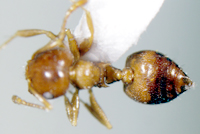Identification: How do I spot them?:
- Have heart-shaped abdomen- when viewed from above
- Workers all one size
- Have 12-segmented antennae and a 3-segmented club
- Coloration varies from light brown to dark brownish black
- Feed primarily on honeydew produced by aphids
- Have two nodes in their pedicel
Typically colonies of acrobat ants are small with a single queen. However, some colonies are rather large and may have thousands of individuals. Colonies are formed after the males and females unite in nuptial flights. Inseminated queens select a nesting site in decaying wood, stumps or logs, and then proceed to make a cavity and lay eggs for the first brood. As the first workers bring in food to the queen, larger batches of eggs are laid and the colonies grow stronger as new, more rigorous workers emerge to assume their tasks in queen care, cleaning, expanding the nest and foraging for colony food.
Distribution: Where are they found?
Acrobat ants, Crematogaster spp. are distributed throughout the United States. They range from the Pacific Coast to the Atlantic seaboard. In the Rocky Mountains range they have been found at an altitude of 7,000 feet. The acrobat ant most commonly encountered in homes in the United States is Crematogaster lineolata (Say) which has many subspecies and varieties. Eastern species also include Crematogaster ashmeadi (Mayr), Crematogaster cerasi (Fitch), and Crematogaster clara (Mayr). A western species of acrobat ant, Crematogaster californica (Emery), occurs in Baja California and other parts of the state. Acrobat Ants nest in decaying tree stumps, fallen trees and limbs. They live in old carpenter ant galleries, termite galleries, in house voids, in walls and especially in voids around doors and window frames and in insulation. A key feature in recognizing acrobat ants is the heart-shaped abdomen that is raised well above the main body when disturbed. This is a defense posture used to avert enemies.
Management: What can you do for them?
The same treatment techniques that apply to carpenter ants can be used on acrobat ants. Finding and treating their colonies in wall voids and wood can usually control these ants. Drilling small holes and dusting the infested areas with insecticide dusts can effectively treat infested walls and voids that harbor these ants. All colonies found outside should be treated directly with a liquid contact spray. Perimeter and foundation treatments of structures with a liquid insecticide will help prevent outdoor foraging ants from entering. Spray applications to trees where Acrobat Ants are located are helpful.
